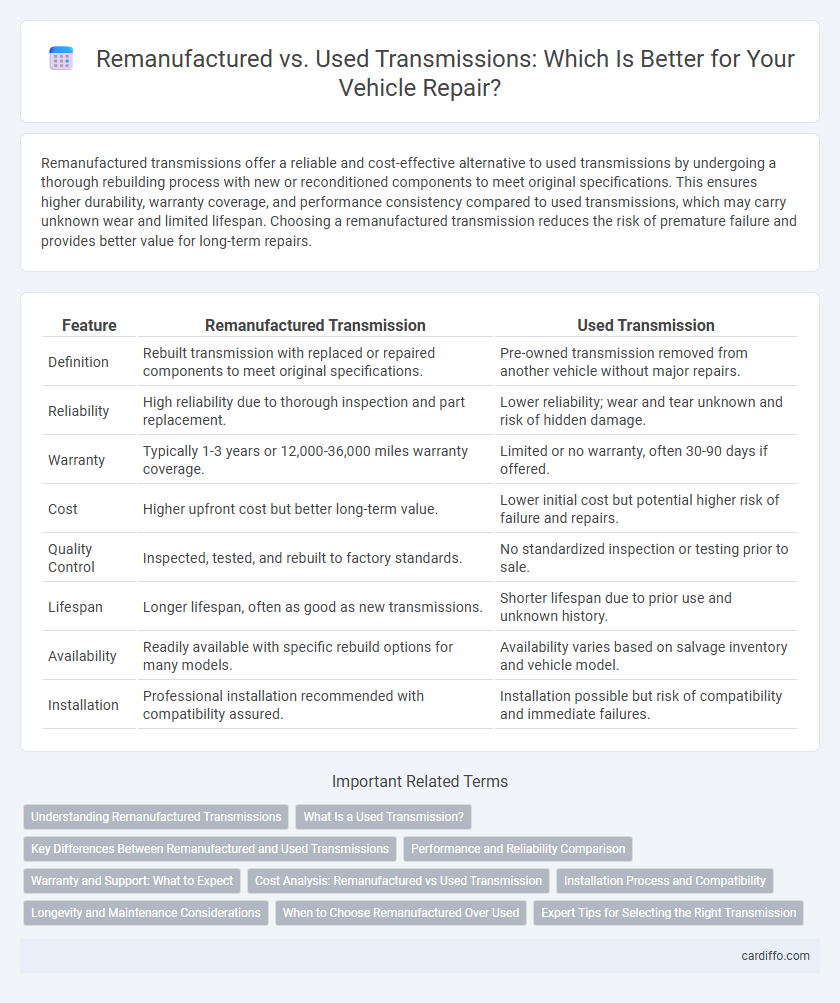Remanufactured transmissions offer a reliable and cost-effective alternative to used transmissions by undergoing a thorough rebuilding process with new or reconditioned components to meet original specifications. This ensures higher durability, warranty coverage, and performance consistency compared to used transmissions, which may carry unknown wear and limited lifespan. Choosing a remanufactured transmission reduces the risk of premature failure and provides better value for long-term repairs.
Table of Comparison
| Feature | Remanufactured Transmission | Used Transmission |
|---|---|---|
| Definition | Rebuilt transmission with replaced or repaired components to meet original specifications. | Pre-owned transmission removed from another vehicle without major repairs. |
| Reliability | High reliability due to thorough inspection and part replacement. | Lower reliability; wear and tear unknown and risk of hidden damage. |
| Warranty | Typically 1-3 years or 12,000-36,000 miles warranty coverage. | Limited or no warranty, often 30-90 days if offered. |
| Cost | Higher upfront cost but better long-term value. | Lower initial cost but potential higher risk of failure and repairs. |
| Quality Control | Inspected, tested, and rebuilt to factory standards. | No standardized inspection or testing prior to sale. |
| Lifespan | Longer lifespan, often as good as new transmissions. | Shorter lifespan due to prior use and unknown history. |
| Availability | Readily available with specific rebuild options for many models. | Availability varies based on salvage inventory and vehicle model. |
| Installation | Professional installation recommended with compatibility assured. | Installation possible but risk of compatibility and immediate failures. |
Understanding Remanufactured Transmissions
Remanufactured transmissions undergo a thorough process where all worn components are replaced or restored to meet original equipment manufacturer (OEM) specifications, ensuring enhanced reliability and performance compared to used transmissions. Unlike used transmissions, which are resold as-is with limited inspection, remanufactured units offer extended warranties and reduced risk of premature failure due to rigorous testing and quality control. Choosing remanufactured transmissions supports long-term vehicle durability and cost-efficient repairs by minimizing unexpected breakdowns and maintenance needs.
What Is a Used Transmission?
A used transmission is a pre-owned gearbox removed from another vehicle, offering a cost-effective repair option compared to brand-new or remanufactured units. These transmissions typically come with limited or no warranties, posing potential risks regarding reliability and lifespan. Choosing a used transmission requires careful inspection of mileage, condition, and compatibility to avoid future repair expenses.
Key Differences Between Remanufactured and Used Transmissions
Remanufactured transmissions undergo a comprehensive process where all worn or damaged parts are replaced or machined to meet OEM specifications, ensuring like-new performance and reliability. Used transmissions come directly from salvaged vehicles without full inspection or refurbishment, making their lifespan and functionality unpredictable. Choosing a remanufactured transmission offers warranty coverage and quality assurance, whereas used transmissions typically lack guarantees and carry higher risks of premature failure.
Performance and Reliability Comparison
Remanufactured transmissions undergo thorough rebuilding and testing processes, ensuring restored performance and enhanced reliability compared to used transmissions, which may have unknown wear and potential hidden damage. Reman transmissions typically include updated components and manufacturer warranties, reducing the risk of premature failure and costly repairs. Used transmissions, while often less expensive upfront, carry higher uncertainty around lifespan and consistent functionality, impacting overall vehicle performance and dependability.
Warranty and Support: What to Expect
Remanufactured transmissions often come with comprehensive warranties lasting 12 to 24 months, covering parts and labor, providing greater peace of mind compared to used transmissions, which typically offer limited or no warranty. Support for reman transmissions includes thorough quality inspections and customer service, ensuring reliability and assistance if issues arise, whereas used transmissions generally lack such extensive backing. Choosing a remanufactured transmission can lead to lower long-term repair costs due to the robust warranty and dedicated support services.
Cost Analysis: Remanufactured vs Used Transmission
Remanufactured transmissions generally cost 20-40% more than used transmissions but offer significantly higher reliability and longer warranty periods, often ranging from 12 to 36 months. Used transmissions are cheaper upfront, typically costing 30-50% less than remanufactured units, but come with increased risk of premature failure and limited warranties, usually 30-90 days. Evaluating total cost of ownership reveals that remanufactured transmissions may save money over time by reducing the likelihood of costly repairs and downtime.
Installation Process and Compatibility
Remanufactured transmissions undergo a thorough rebuilding process that ensures all components meet original manufacturer specifications, resulting in higher reliability and often a warranty that covers installation issues. Used transmissions may have unknown wear and lack thorough testing, leading to potential compatibility problems and a more complex, risk-prone installation process. Choosing a remanufactured transmission reduces installation errors and ensures better fitment with the specific vehicle model compared to used alternatives.
Longevity and Maintenance Considerations
Remanufactured transmissions typically offer greater longevity due to the replacement of worn components and adherence to factory specifications, reducing the likelihood of frequent repairs. Used transmissions may have unknown wear levels and lack warranty coverage, leading to unpredictable maintenance costs and shorter service life. Choosing a remanufactured transmission often results in improved reliability and lower long-term maintenance expenses compared to a used unit.
When to Choose Remanufactured Over Used
Choosing a remanufactured transmission over a used one is ideal when reliability and warranty coverage are priorities, as remanufactured units undergo rigorous testing and replacement of worn components to meet OEM specifications. Remanufactured transmissions offer improved longevity and performance consistency compared to used transmissions, which may have unknown wear and potential hidden defects. Opt for remanufactured transmissions in cases of high-mileage vehicles or when aiming to avoid costly repairs shortly after installation.
Expert Tips for Selecting the Right Transmission
When selecting the right transmission, consider that remanufactured transmissions offer a balance of reliability and cost-effectiveness due to their rebuilt components meeting OEM standards. Used transmissions provide a lower upfront price but carry higher risks of unknown wear and shorter lifespan. Expert tips emphasize verifying warranty terms, assessing component condition, and ensuring compatibility with your vehicle model to make an informed decision.
remanned transmission vs used transmission Infographic

 cardiffo.com
cardiffo.com